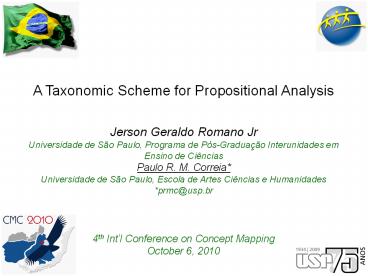A Taxonomic Scheme for Propositional Analysis PowerPoint PPT Presentation
Title: A Taxonomic Scheme for Propositional Analysis
1
A Taxonomic Scheme for Propositional Analysis
Jerson Geraldo Romano Jr Universidade de São
Paulo, Programa de Pós-Graduação Interunidades em
Ensino de Ciências Paulo R. M.
Correia Universidade de São Paulo, Escola de
Artes Ciências e Humanidades prmc_at_usp.br
2
(No Transcript)
3
(No Transcript)
4
Literature review
- Dynamic thinking CMs
5
Literature review
6
Literature review
7
Literature review
- Dynamic thinking MCs
8
Literature review
- Causative non-causative propositions
9
Our taxonomic scheme
10
Research objective
- Develop a taxonomic scheme for propositional
analysis - Compare Cmaps made by different students
- Science-Technology-Society approach
Our hypothesis
- More dynamic propositions, more understanding
about STS
11
Data collection
- Setting
- 1st year students at Universidade de São Paulo
- ACH0011 Natural Science course (15
weeks-2h/week) - Total set of Cmaps n55
- Total set of propositions n825
12
Data collection
- Experimental conditions
- Half-structured concept map (HSCmap)
- How-type focal question
- How does bioethics regulate the relationship
between science and society? - Quantified concepts were required
- More technology (root concept) more controversy
13
How to use our taxonomic scheme?
14
Data analysis
- Descriptive statistics univariate approach
- Evaluation of the proposed variables
(S/D11/D12/D21/D22/D23) - Exploratory analysis multivariate approach
- Hierarchical Cluster Analysis (HCA)
- Pattern identification through Cmaps natural
clustering
15
Results and discussion
- Descriptive statistics univariate approach
- Box-plots
16
Results and discussion
- Dynamic thinking stimuli
- A props w/ more technology were not
considered - Knock out the quantified root concept effect
(mainly on ?D22/?D23) - B How-type focal question effect
- Props w/ more technology more controversy
were not considered (?S/?D11/?D21
?D12/?D22/?D23)
17
HCA X(55,6)
- City-block (Cmaps distance) Wards (clusters
distance)
18
Clusters description
19
Illustrative Cmaps (Cluster IV ?S)
20
Illustrative Cmaps (Cluster I ?D11/?D12)
21
Illustrative Cmaps (Cluster II ?D22/?D23)
22
Conclusions
- Propositions are critical to understand Cmaps
- There is latent information to be unveil
- Our taxonomic scheme
- Deep evaluation of props (S/D11/D12/D21/D22/D23)
- More objetive (4-question procedure for
classification) - Students under the same experimental conditions
- Cmaps w/ different kinds of props
- Descriptive props (Cluster IV, ?S)
- Non-causative props (Cluster I, ?D11/?D12)
- Causative props (Cluster II, ?D22/?D23)
- Soon
- This work will be submitted to J. Res. Sci.
Teach.
23
CMC 2014 in Brazil
24
(No Transcript)
25
(No Transcript)

